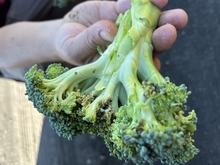Twenty minutes into a 2020 meeting of Minnesota Fruit and Vegetable Growers Association members, it started taking on an element of group therapy. The topic of the day? Black rot, a disease that has taken hold in broccoli crops, especially among organic growers.
“We’ve all been there with you and it’s an awful feeling,” one member told farmer Rodrigo Cala, who said that he lost 75% of his broccoli to disease the previous year.
“We just threw it away,” Cala told the others. “It was really sad.”
Guests in attendance that day brought hope: Natalie Hoidal, University of Minnesota Extension vegetable crops educator; Charlie Rohwer, University of Minnesota researcher at the Southern Research and Outreach Center in Waseca (SROC); and Nicolas Enjalbert, CEO of Seedlink, a business that supplies seeds for food, grass and forage crops.
They came to invite farmers to participate in a research project made possible through a Minnesota Department of Agriculture Specialty Crop Block Grant.
80 growers help evaluate varieties
Climate projections predict more precipitation, with higher temperatures and hotter nights, which can translate into more disease and disorders related to heat stress. Organic growers have fewer options to stop diseases from spreading.
“Variety selection is one strategy farmers have,” says Hoidal. “We wanted to test broccoli varieties from our region, from new breeding lines and from other parts of the world.”
Rohwer and Hoidal introduced the bacteria that cause black rot to an SROC plot, using best practices so they wouldn’t spread the disease beyond the plot. They watched for how varieties performed, and how well they resisted disease.
Meanwhile, 80 farmers and gardeners each grew a subset of the broccoli varieties and evaluated them on disease resistance, heat stress, vigor, taste and yields.
Thanks to an app developed by Seedlink, submitting results was as easy as going to their cell phones.
Local broccoli is worth it
By fall 2021, Hoidal and Rohwer had identified varieties that performed well under hot conditions with high disease pressure. Luna, Diplomat, Monty and Imperial had the most consistently high disease tolerance rankings across trials. The report is available at z.umn.edu/broccoli-trials.
“Finding a disease-resistant variety of broccoli is so important for us because, in our experience, broccoli is the most susceptible to black rot,” says Erin Johnson, who owns Open Hands Farm in Northfield with her husband, Ben. “It seems to start in our mid-summer plantings and, over the course of the fall, it spreads to other brassica plants.”
Although Open Hands Farm doesn’t survive on broccoli alone, they want to be able to provide a local source for families and school kitchens. “Kids love it,” she says.
“It is sweet and our customers say that it is very flavorful.”
Permission is granted to news media to republish our news articles with credit to University of Minnesota Extension. Images also may be republished; please check for specific photographer credits or limited use restrictions in the photo title.



